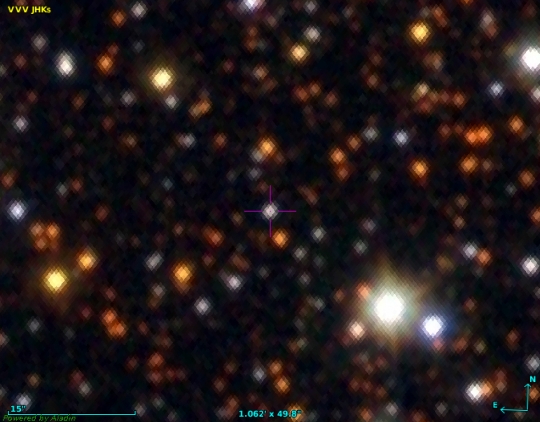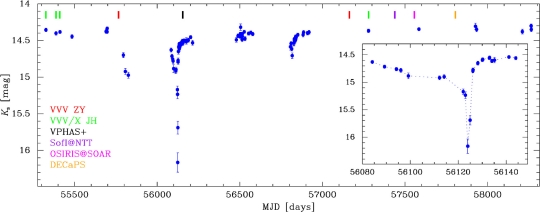VISTA (Visible and Infrared Survey Telescope for Astronomy) is a near-infrared instrument located at the European Southern Observatory’s Paranal site, and is by all accounts the world’s largest survey telescope, with extremely wide field of view and sensitive detectors. On the peak next to ESO’s Very Large Telescope (VLT), VISTA shares its exceptional viewing conditions using a 4.1-meter primary mirror and a three-tonne camera with 16 infrared detectors.
With its time devoted to six surveys ranging from complete southern sky coverage to small patches of sky looking for extremely faint objects, VISTA was bound to come up with interesting data, especially in the survey known as VVV, which stands for VISTA Variables in Via Láctea. Here, astronomers are homing in on regions that are obscured by dust in the bulge and southern Galactic disk, using pulsating RR Lyrae and Cepheid variables as distance indicators, with a focus on microlensing events, eclipsing binaries and pre-main sequence variable stars.

Image: VVV-WIT-07 in the centre of a star field. Credit: Saito et al.
This is fertile ground for discovery, but even so, the object known as VVV-WIT-07 is taking everyone a bit by surprise. We’re dealing with a star that reminds everyone of Boyajian’s Star (KIC 8462852), famed for its unusual dips in lightcurve. Were they signs of a Dyson Sphere under construction, or a natural phenomenon the likes of which we had never seen? Uneven rings of dust, dusty planetesimals or comets are still in contention. Now we have a star that is apparently even more extreme, one whose range in lightcurve variation is extraordinary. Viewed by the survey over a period of eight years, VVV-WIT-07 has been seem to dim first by a factor of 2, then by almost 80 percent. A week later, it was back to normal.
Here’s what the ESO blog had to say about the matter:
“The first observations showed nothing strange — simply a mild scatter in the brightness measurements, consistent with the observational uncertainties. However, in August-September 2011, just before the end of the observing season, the star dimmed by a factor of almost two! By June 2012, when we began re-observing it, the star’s brightness was nearly back to normal. But by mid-July, it had dimmed by almost 80%! Then it was back to its usual self in about a week. The data taken since then contain hints of additional drops in brightness, but nothing so dramatic.”
The WIT designation is fun — it stands for What Is This, and the VVV team is using it to describe any objects that do not apparently fit known classes of stellar variability. WIT may remind you of another appellation for Boyajian’s Star, which was the ‘WTF Star,’ its ambiguous acronym standing surely for ‘Where’s the Flux?’ Have a look at the lightcurve of VVV-WIT-07:

Image: Lightcurve of VVV-WIT-07 showing how it varied in brightness between 2010 and 2018. The insert shows an expanded view of the particularly dramatic dimming event that occurred in July 2012. Credit: Saito et al.
Is it possible we are looking at some kind of circumstellar disk with huge variations in it, a clumpy disk that blocks the star’s light in this highly irregular way? The odds on that seem long. Here is what the paper says:
Alternative scenarios for VVV-WIT-07 include a “dipper” T Tauri star with clumpy dust structures orbiting in the inner disk that transit our line of sight (e.g. Rodriguez et al. 2017), or even a long period, high-inclination X-ray binary. The deep, narrow eclipse delayed with respect to a broad and shallower dip is reminiscent of the morphology seen in high-inclination low-mass X-ray binaries (LMXB, e.g. Parmar et al. 1986; Baptista et al. 2002). However, LMXBs are restricted to orbital periods of less than a few days while high-mass x-ray binaries (HMXB) can be found at Porb up to hundreds of days (e.g. X1145-619 has Porb = 187.5 d, Watson et al. 1981). Moreover, in this scenario optical and IR spectra would be dominated by the mass-donor companion star, and should show rotationally-broadened hydrogen absorption lines at epochs of no mass ejection episodes, which is not the seen in the spectra of VVV-WIT-07.
So we have something that gives us echoes of Boyajian’s Star, and may also remind us of Mamajek’s Object (J1407), an interesting pre-main sequence K5 star with a ring system eclipsing it. Or something we haven’t yet identified, perhaps in the form of multiple objects, may be moving between us and the host star, even a dense family of comet-like objects. VIV-WIT-07 would be easy enough to explain if it were a binary, but the observations clearly rule that out.
VISTA has observed VIV-WIT-07 85 times already. Needless to say, it will be the subject of even more intense scrutiny. The paper also notes recent discoveries like OGLE LMC-ECL-11893, an eclipsing star consistent with a dense circumstellar dust disk structure, and PDS 110, an eclipsing system with likely transits by a companion with a circumstellar disc.
The paper is Saito et al., “VVV-WIT-07: another Boyajian’s star or a Mamajek’s object?” in process at Monthly Notices of the Royal Astronomical Society (preprint).



You have to excuse my ignorance (and bad english) but why can this not be the result of one celestial body, or several (or that solar systems own “asteroid belt”) for that matter, passing in front of the star from from our point of view? Of course I would love us to find a Dyson sphere construction site, but any planet/planets or asteroid belt passing in our line of sight just seems to be the most simple and logical explanation? Thanks for an inspirational blog Paul!
Thanks for being here, Daniel. And yes, I think we’re looking at something passing between us and the star, doubtless with an astrophysical explanation, and perhaps one that will teach us something interesting about disks!
Just weird. For an object to block up to 80% of the starlight, its diameter would need to be at least about 90% of the star assuming 100% opacity and perfect alignment from our viewpoint. Blocking light for up to 2 weeks indicates an extent of millions of kilometers at any reasonable orbital velocity; definitely not a planet nor a planet with any conceivable array of moons. Could it be some extremely odd/chaotic variable star? A close binary with weird interactions? Total guesses, of course.
Dust clouds can easily fit this bill, they can have large extent (up to a circumstellar disk) and 100% opacity, both. One type of such dust cloud is a comet’s tail, thus the hypothesis that irregular occlusions could be caused by an irregular swarm of comets. The good part of that hypothesis is that comets have regular orbits, so over time it should be possible to identify repetitive patterns to confirm the hypothesis.
Wonderful to see your name pop up again, Eniac! A long-time reader indeed.
A planet would generate a symmetrical dip. It needs to be something much more complex.
A planet having quasi-satellite objects (should be ordinary rocks) orbiting around a star could create very complicate light curves. Also, if one adds more objects in horseshoe orbit, then the layer of complexity will increase even more.
Very interesting! There is also a Zooniverse project for this survey, where you can look at lightcurves nobody has seen before:
https://www.zooniverse.org/projects/ilacerna/variable-star-zoo
Serious question: If micro-lensing can help you see an object for a short while, can’t it hinder you in seeing it, too? Converging lenses increase intensity at the focus, but they do it by robbing intensity outside the focus.
Could we be looking at a near miss micro-lensing event?
“can’t it hinder you in seeing it, too?”
No, there is no dimming. A microlensing event creates simply a peak in the lightcurve.
Before we can determine what exactly is going on here, we need to know a lot more about the star. Initially I thought this to be a KH 15d analog, but that is now obviously not the case because it is a single star and not a binary. To me, that leaves only a Boyajian’s Star analog or a Mamajek’s Object analog. A “V” spectral type would make it a Boyajian’s Star analog. Any other spectral type would make it more of a Mamajek’s Object analog.
An 80% dimming of the star’s light would imply an absolutely enormous number of objects. I’m not clear on what the time duration of the dimming was based on the graph. The dip is extremely sharp. The authors are suggesting it is unlikely to be a single object. Is it possible a massive dust cloud travelling rapidly across the telescope’s field of view would produce this result? I think the infrared spectrum should provide evidence for this as it has for the dimming at Boyajian’s star I believe. Can anyone comment on this?
Here’s my two cents on this, although probably not even worth two cents since the pros didn’t mention this as a possibility:
Not all stellar accretion disks are ovals. Spiral arm shaped dust bands have been observed orbiting some young stellar objects (YSOs). If this star is in its T Tauri phase it is a YSO. I’m thinking that the light curve dips are caused by transiting gas giant planets. The deepest dip is caused by a rapidly accreting giant planet located at the terminus of a thick dust accretion arm. In other words the accretion disk ends at the planet, which is why the larger dip has such an abrupt cutoff.
I immediately realized upon reading what I had just submitted why it wasn’t worth two cents: If my idea was correct the partial light dip would trail the planet rather than leading it, I think. Never mind.
It should be possible to feed anomalous data sets to a computer along with resolved/explained anomalies, understood variants and scientifically sound speculations; after they are all digested, see the output from the computer.
The thing is, what do we actually know about all the space between us and that star? Do we know all the stars that has orbits passing in or line of sight? Could it be several “asteroid belts” in different solar systems that passed in front of the star in our line of sight? Im not even at the level of a novice when it comes to astronomy, but I feel like there are so many unknowns..?
Astronomers would know that, except for extremely thin dust, the space between us and that star would be empty. The average distances between stars is very large, so large that even things as broad as our solar system are tiny in comparison. They should be able to rule out other systems in our line of sight Daniel.
Thanks Paul
Another very interesting article on an interesting Star it will be interesting to see what results are published on this one now to read the paper